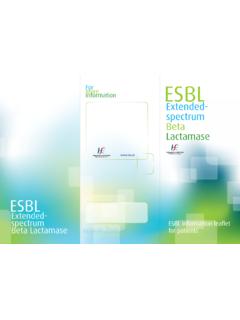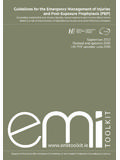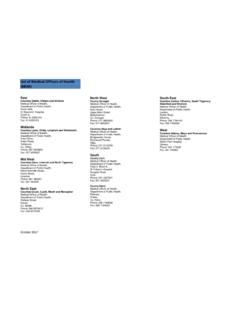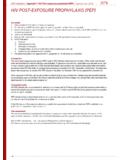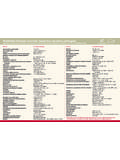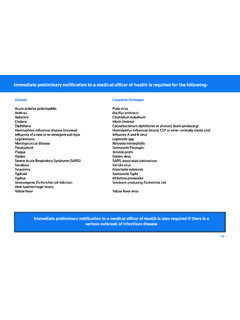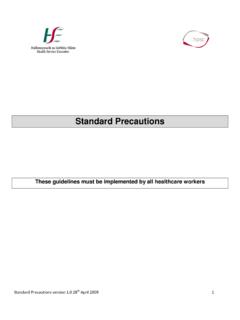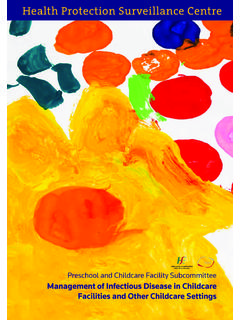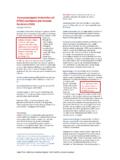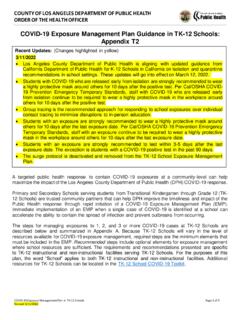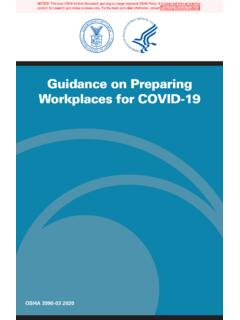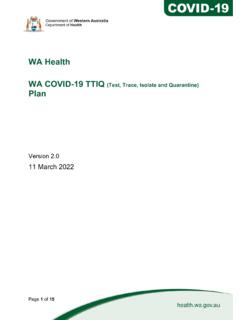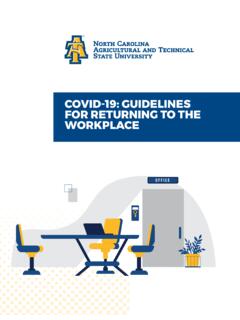Transcription of General guide on management of COVID-19 outbreaks in …
1 HSE Health Protection Surveillance Centre Page 1 of 10 General guide on management of COVID-19 outbreaks in non-healthcare workplace settings Version Publication Date: 14/04/2022 This document is intended as a General guide to management of COVID-19 outbreaks in non-healthcare workplace settings (including chilled air environments). This document should be used in conjunction with the Transitional Protocol Good Practice guidance for Continuing to Prevent the Spread of COVID-19 . All HPSC guidance should be read and interpreted in conjunction with Government guidance . This document is uncontrolled when printed.
2 HSE Health Protection Surveillance Centre. Page 2 of 10 Version History Version Date Changes from previous version 14/04/2022 Added link to updated RCF guidance 31/03/2022 Full update of guidance document 27/01/2022 Updated sections on outbreak management , updated links to National Contact Tracing guidance . Updated links to Transitional Protocol 20/01/2022 Updated links to National Contact Tracing guidance and algorithms. 17/11/2021 Change of language 21/06/2021 Clarification that those who are symptomatic should be tested, even if vaccinated. 01/06/2021 Clarification positive cases, even if vaccinated, should self-isolate 10/02/2021 Updated guidance for close contacts who have significant vaccine protection 22/11/2020 Updated close contact testing HSE Health Protection Surveillance Centre.
3 Page 3 of 10 Introduction COVID-19 can produce a variety of symptoms ranging from mild to moderate and severe disease, with some cases being fatal. Some individuals have risk factors that place them at higher risk of adverse outcomes. Therefore it is important that employers engage with all employees who are at high risk or very high risk and are likely to be particularly worried about returning to the workplace . Individuals in these high risk or very high risk groups should ensure they have received their COVID-19 vaccine and a booster dose. They should also wear a medical grade (surgical) or FFP2 mask in indoor or outdoor crowded places and should follow the advice on how to protect themselves from COVID-19 .
4 A phased return to physical attendance in the workplace has commenced, although this depends on the circumstances of the individual workplace . To support the transition back to physical attendance in the workplace , and the continued safe operation of workplaces, a Transitional Protocol was developed. This can be found here: - Transitional Protocol: Good Practice guidance for Continuing to Prevent the Spread of COVID-19 ( ). Purpose The purpose of this document is to provide a General guide on the management of COVID-19 outbreaks within non-healthcare workplace settings (including chilled air environments).
5 Definition of an outbreak Full access to the definition of an outbreak can be found here: HSE Health Protection Surveillance Centre. Page 4 of 10 General public health advice It is advised that all staff should follow the below recommendations within the workplace (including chilled air environments): Get vaccinated Vaccination offers the best protection against severe disease and hospitalisation for you, your family and for others Self-isolate if you develop symptoms of COVID-19 until 48 hours after your symptoms are substantially or fully gone Clean your hands thoroughly and regularly Demonstrate good respiratory hygiene and cough etiquette Wearing a face covering/mask is no longer mandatory, but is still advised on public transport, and in healthcare settings.
6 Follow all measures identified in your health and safety risk assessment in relation to mask wearing in the workplace When meeting indoors, maintain good ventilation. In settings where ventilation is not optimised, prioritise meeting outdoors, rather than indoors People who are at very high risk or high risk of severe COVID-19 can follow the General public health guidance that applies to everyone once they have vaccine protection. Those who are unable to be vaccinated may need to take extra precautions. Ventilation It is important that employers ensure optimal ventilation of any indoor spaces (including chilled air environments), either through natural ventilation ( opening windows and external doors) or by mechanical means ( central air-conditioning unit) Carbon dioxide (CO2) monitoring is also likely to be beneficial in raising a person s awareness of ventilation requirements and has been used to inform individual behaviour in improving ventilation Please see here for further information.
7 HSE Health Protection Surveillance Centre. Page 5 of 10 Infection Prevention and Control (Hygiene measures) It is recommended for employers that they ensure hand washing facilities or alcohol-based hand gel are available throughout the workplace to facilitate workers adhering to hand hygiene measures Workplaces should review and update their occupational health and safety risk assessments and safety statement as workers return to the physical workplaces to take account of changed public health advice. Please see here for further information. A policy of good respiratory hygiene and etiquette is also still necessary Outside of regulated settings, it is still good practice to continue to use a face covering/mask particularly in crowded areas.
8 Requirements for face coverings/masks in the workplace will be outlined in the workplace occupational health and safety risk assessments. Workplaces should follow relevant specific guidance in relation to the frequency of cleaning and sanitising. For further information see: o Department of Agriculture o Health and Safety Authority o Food Safety Association of Ireland The frequency of sanitising and fogging should be implemented where relevant, based on occupational health and safety risk assessment All employed or contracted cleaning staff should be trained in the correct use of the cleaning materials.
9 They should abide by the workplace rules as to when and where protective clothing is to be worn Additional staff or replacement staff must also be properly trained in cleaning techniques and know the cleaning SOPs thoroughly. HSE Health Protection Surveillance Centre. Page 6 of 10 Investigation and management of COVID-19 cases and contacts The primary objective of managing an outbreak is to reduce the risk to the workforce and public health by containing the disease and preventing secondary spread. In the case of COVID-19 , the objective is to identify positive cases as soon as possible.
10 Positive cases should follow current advice as outlined in Public Health Advice for management of COVID-19 cases and contacts. In addition to this document, it is important that: 1. Any staff member, regardless of vaccination status, who develops symptoms while at work, should be immediately isolated, sent home and should get tested where appropriate. 2. There should be a designated isolation room onsite for symptomatic staff. This should be cleaned after a suspected or confirmed case leaves. Medical grade (surgical) or FFP2 face masks should be provided for every person using this room.
